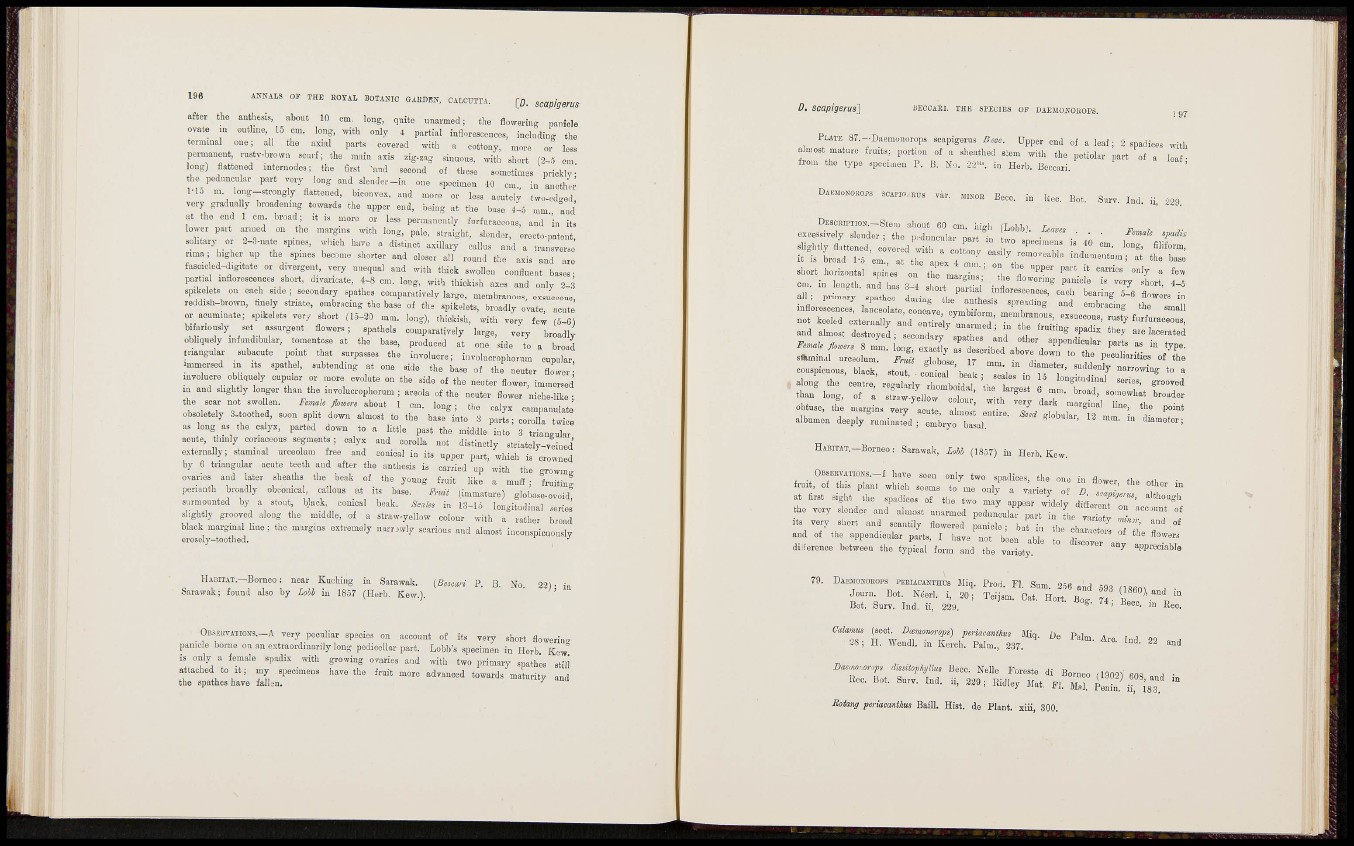
196 ASKALS OP THE EOYAL flOTANIC QAUDISN. CAtCnTlA
[¿3. scapigerus
after the hes.s, .bo„t 10 cm. long, quite unarmed; the S o . e r i n g p.nfcle
ovate .n outline, lo om. long, with only 4 partial inflnreaceuoes, including the
tenmnal one; all tlia axial parts corerod with » cottony, more o. less
pernranent, r u s t y - h r o „ , scurf; the main axis .ig-.ag sinuous, with short (2-5 on,
long) ilattoned rnternodes; the first "and second of the.e somotime. priokly'
he pedunoulav part very long and s l e n d e r - i n one specimen 10 cm., in anotherl
- l o m long-strongly tlattened, biconvex, and more or less acntelv („„-edged
very .gradually Inoademng towards the upper end, being at the base j'-o mm and
at the end 1 em broad; it is more or less permanoutl, fortnraocoas, and "in its
lower part armed on the margins with long, pale, straight, slender, orecto-p.tont,
solrtary or 2-3^nate spmes, wh.eh have . distinct axillary callus and u transverse
r i m a ; higher np the spmes become shorter and closer all round the axis and are
fasOMled-digitate or divergent, very unequal and with thick swollen confluent basespartial
inflorescences short, divaricate, 4-8 cm. long, with thiokish axes and only 2 3
.pikelets on each .ide ; secondary spathes comparatively large, membranous, exsuccon.
reddish-brown, niiely striate, omhr.eing the base of the ,pikelets, broadly ovate acute
or acuminate; .pikelets very short (1.3-20 mm. long), thickish, with very iew (o 6)
Mfariously set assurgent flowers; spall,els comparatively lar-e, very broadly
ohKquely mfundibular, tomentose at the base, produced at one side to a bro.d
triangular .ubacute point that surpasses the involucre; involncrophorum cunnlar
immersed in its spathel, subtending at one side the base of the neuter flowermvolncre
ob wuely cupula,- or more evolute on the .ide of the neuter flower, immersed
,n and slightly l o y r than the luvolucrophorum ; areola of the neuter flower niehe-likethe
sear not swollen. Femah JhwBrn about I cm Inn^ - M... , '
ebsoletely S.toothed, soon split down almost to t h T ' b l ^ i ; J ' T . p t l ; e ^ X t " I
as long a, the calyx, parted down to a little past the middle into 3 triangular
acute, thmly coriaceous segments; calyx and corolla not distinctly striately-veined
externally; staminal urceolum free and conical in its upper part, which is crowned
by 6 triangular acute teeth and after the anthesis is carried up with the grow.n,
ovar.e. and later sheaths the beak of the young fruit like a mnfl ; fruiting
perianth broadly obconical, callous at its base. P„U (immature) globose-ovoid
surmounted by a stout, black, conical beak. S„k, in 13-15 longitudinal series
slightly grooved along the middle, of a straw-yellow colour with a rather broad
black mai-ginal l i n e ; the margins extremely n a r i j w l y scarious and almost inconspicuously
ei-osely-toothed. '
Habitat.—Borneo: near Kuching in Sarawak. [Beam P. B. Ho 32)- in
Sarawak; found also by Ubh in 18.57 (Herb. Kew.). '
OBse,ivA,io:,s.-A very peculiar species on account of its very short flowering
pamole borne 0» an extraordinarily long pedioellar part. Lobb's specimen in Herb Kew
is only a female .padix with growing ovaries and with two primary spathes stili
attached to i t ; my specimens have the frnit more advanced towards maturity and
the have fallen.
D. scapigerus:] BECCAKI. THK SPECIES OF DAEMOKOllOPS.
PlATU Sr.-Daemonorops scapigei-us Bece. Opper end of a leaf; 2 spadices with
almost mature fruits; portion of a .heathed .iom with the petiolar part of a I,.„rfi
om the type specimen P. B. No. 22"'. in Herb. Beccari. '
Daioiokohops scapio-h™ var. „ m h Becc. in [ice. Bot. Surv. Ind. ii, 229.
short horizontal .pi es on th m L T . - ' L fl' ' »
cm, in length, anS has 3-4 i i l ^ Z ^ ^ e ^ t a l g T ^ T '
all ; primary .pathes during the anthesis spreading and e X o i n r I "
and almost destroyed; . e e o n d a r y ^ - p r r „ d " I V ' t p - p l r t T
oouspieuou, black, -tout, . eoni ' bc k - . " l . " in H l " " H-""',^ »
^ t : — f - f •
» . u s e , t £ t::; ?
albumen deeply ruminated ; embryo basal. ' ''«"•'»'"'i
HffllTAT.-Borneo.- Sarawak, ZoU (1857) in Herb. Kew.
at lirst sight .he spadices of the two may appe;, t a e l y dfs T '
the very slender and almost unarmed peduimnla? p " t n L vt e^
Its very short and scantily flowered panicle; bni in the 7 J T '
and of the appendicular parts, I have not been able to diselt
di^'erence between the typical form and the v a l ty
79, Dab-uohoeops pemaoahthos Miq. Prod. Fl. Sum. 2-56 and 693 „ « « „ , , .
Joui-n Bet Werl. i, 20; Teiism, Cat. Hort. Bog 7
Bot. Surv. Ind. ii, 229. ' ^ec.
Calamm (sect. Dwmomops) fenaeathm Miq. Oe Palm A i „
28; H. Wendl. in Kerch. Palm., 237.
I>ac,m,or,p, dmitophill,,, Becc. -»lelle Foreste di Borneo ,190PV Rn» .. -
tiee. Bot. Surv, Ind. ii, 229; Ridley Mat. Fl. m T C n . ^ ^ i s s "
Moias ferimatilm Baill. Hist, do Plant, xiii, 300.